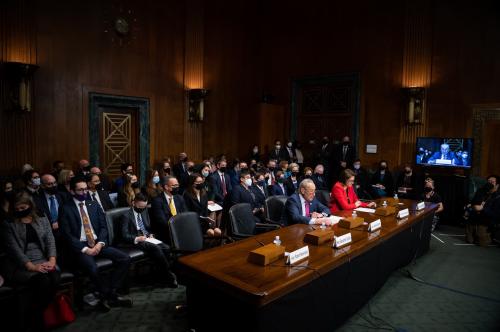With exactly a year until the 2000 election, it is still not too late for Congress to give the next administration a chance to hit the ground running by providing the funds for pre-election transition planning. The funding would yield dividends far into the future. We can pay the candidates now for transition planning, or pay the costs of delayed appointments, missed opportunities and bad decisions later.
It is not as if the federal government does not care about the transition, however. The General Services Administration already pays most transition costs after the election is over, from moving vans for the incoming and outgoing Presidents to staff and office space for the transition team.
The federal government also foots the bill for much of the campaign activities before the election, including $8 million for two national party conventions and $20 million for each of the major candidates. If taxpayers are willing to see millions spent on balloons and confetti, one suspects they would gladly endorse a few hundred thousand dollars to do a little advanced planning for the real event—the transition to governing.
The problem is that Congress and past presidents have seen pre-election transition planning by both candidates as wasted money. After all, one of the two is going to lose, meaning at least one set of files will end up in the Dumpster.
The candidates and their consultants are not much better. To be generous, some rightly worry that the public will read pre-election transition planning as a sign of overconfidence, while distracting the campaign team from the task at hand?winning the election. But ample evidence shows that the political strategists would rather risk a failed transition than lose the inside track to a West Wing office. They are not working to win the election so that some policy wonk or public administrator can start governing without their permission.
One need only look back to 1992 to see how that attitude plays out. Clinton’s transition was an utter disaster. His campaign team’s “Carville-ier” attitude toward governing showed in the wild ride of missed appointments and bad decisions that marked the first year and beyond. By the time the Clinton team was up to speed, they had squandered what little political capital they had reaped from the President’s razor thin victory. There were many culprits in the disastrous health care plan?many of them finding new life in the First Lady’s Senate campaign?but the lack of pre-election transition planning marked the start of what would become a long slide to minority status on Capitol Hill.
The current crop of presidential hopefuls would be well advised to think further back in time to 1980, when Ronald Reagan broke all the political rules by establishing a transition operation in early spring. The operation was completely separate from the campaign, thereby insulating it from the consultants. The result was one of the fastest starts in modern presidential history, and dramatic budget and tax victories in a then-Democratic Congress.
Even with this jump-start, Reagan’s Cabinet entered office later than Carter’s, which entered later than Nixon’s, which entered later than Kennedy’s. It was a harbinger of the complete breakdown of the presidential appointment process that plagues government today. Hence, Bush’s Cabinet entered later than Reagan’s, and Clinton’s entered later than Bush’s. Those who survive the battering enter office frustrated and fatigued.
Ultimately, it is up to the candidates to commit to pre-election planning. The Democratic and Republican nominees could sweep away much of the old resistance by launching transition planning operations on the same day. But Congress can also improve the odds of that handshake by giving the national party committees a small allotment for pre-election planning.
There is a precedent for the idea. The Senate passed just such a proposal as part of the 1988 Presidential Transitions Effectiveness Act only to lose it in conference with the House Government Operations Committee when the chairman, Texas Democrat Jack Brooks, refused to yield on giving $250,000 to the losing party. It was, as he labeled it, a National Enquirer issue. That was twice in four years I lost the battle for transition planning. I drafted the proposal on behalf of the Senate Governmental Affairs Committee in part because I had seen first hand how hostile the political staff can be toward transition planning in John Glenn’s 1984 presidential campaign.
An outright appropriation is hardly the only way to promote pre-election planning. Congress could require that balloons be spared at the national conventions, or cut back floor signs and convention buttons, and then give the savings to planning. It is amazing how quickly the balloons would add up to a planning effort. Now that is a campaign for good government worth waging. With just 365 days until the election is over, there is no time like the present to get started. And what taxpayer could resist a cut in confetti?

Commentary
Worth the Price of Confetti
November 1, 1999